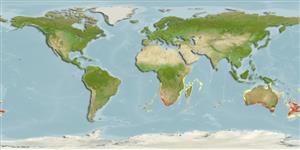Common names from other countries
>
Gadiformes (Cods) >
Moridae (Morid cods)
Etymology: Tripterophycis: Greek, tres tria = three + Greek, pteron = wing, fin + Greek, phyke, pykis, -idos = the female of a fish that lives among algae (Greek = phykon), related with the gudgeon (Ref. 45335).
More on author: Boulenger.
Environment: milieu / climate zone / depth range / distribution range
Ecología
marino batidemersal; rango de profundidad 100 - 1000 m (Ref. 1371). Deep-water; 0°S - 59°S, 13°W - 173°W (Ref. 1371)
Indo-Pacific: southwestern Indian Ocean, Australia, Sumatra (Indonesia) and New Zealand. Also in the mid-south Atlantic.
Tamaño / Peso / Age
Maturity: Lm ? range ? - ? cm
Max length : 33.0 cm TL macho / no sexado; (Ref. 1371)
Espinas dorsales (total) : 0; Radios blandos dorsales (total) : 52 - 58; Espinas anales: 0; Radios blandos anales: 103 - 110. Second and third dorsal fins widely spaced (Ref. 1371). Color pale brown to pink (Ref. 1371).
Occurs on the continental slope (Ref. 9563) to more than 1,000 m (Ref. 1371).
Life cycle and mating behavior
Maturities | Reproducción | Spawnings | Egg(s) | Fecundities | Larva
Cohen, D.M., T. Inada, T. Iwamoto and N. Scialabba, 1990. FAO species catalogue. Vol. 10. Gadiform fishes of the world (Order Gadiformes). An annotated and illustrated catalogue of cods, hakes, grenadiers and other gadiform fishes known to date. FAO Fish. Synop. 125(10). Rome: FAO. 442 p. (Ref. 1371)
IUCN Red List Status (Ref. 130435)
CITES (Ref. 128078)
Not Evaluated
Threat to humans
Harmless
Human uses
Pesquerías: sin interés
Herramientas
Special reports
Download XML
Fuentes de Internet
Estimates based on models
Preferred temperature (Ref.
115969): 7.5 - 14.9, mean 10.3 (based on 152 cells).
Phylogenetic diversity index (Ref.
82804): PD
50 = 0.7500 [Uniqueness, from 0.5 = low to 2.0 = high].
Bayesian length-weight: a=0.00389 (0.00195 - 0.00776), b=3.11 (2.93 - 3.29), in cm Total Length, based on LWR estimates for this (Sub)family-body shape (Ref.
93245).
Nivel trófico (Ref.
69278): 3.0 ±0.18 se; based on food items.
Resiliencia (Ref.
120179): Bajo, población duplicada en un tiempo mínimo de 4.5-14 años (Assuming tmax>10).
Fishing Vulnerability (Ref.
59153): Low vulnerability (23 of 100).
Climate Vulnerability (Ref.
125649): Low vulnerability (6 of 100).
